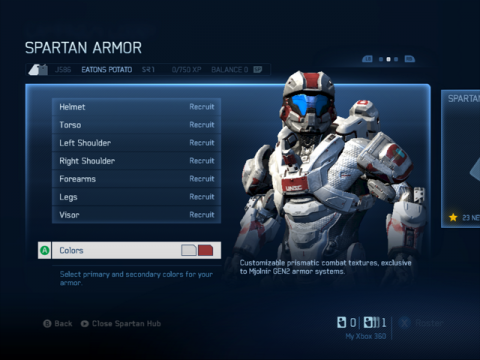
Did the new team at 343 Industries break Halo? No, not at all. Taking over the franchise from its creators at Bungie and creating a new, numbered sequel starring the Master Chief seems like the sort of daunting task that could have blown up the entire franchise if it had gone poorly. But the developers have executed quite well, developing a Halo game that gets that Halo feel down nicely while also playing around with the periphery of the experience in an attempt to modernize things a bit. Some of those new ideas work better than others, but if there's any actual issue with Halo 4 it's that the game plays it a little too safe. Master Chief starts the game surrounded by mystery, but it relies too heavily on the use of existing enemies and weapons, and by the end of the campaign it sort of feels like the Master Chief is right back in the middle of the same conflict and theater of war he seemingly left behind at the end of Halo 3.
The action opens with the Master Chief being woken out of his stasis only to find danger. Covenant forces have boarded his ripped-up ship and this whole mess is headed for a Forerunner planet called Requiem. Before too long a human ship called the Infinity joins the fray, giving you the standard factions of a Halo game. Mixed into this conflict is a new batch of enemies called the Prometheans. And tying it all together is a central bad guy known as the Didact. The story starts to head in some interesting directions. Your ever-present AI pal Cortana, for example, is falling apart due to being "alive" for more than seven years. As she breaks down, it's harder for her to maintain focus and help the Chief complete his tasks. It's also really interesting to put a face to the antagonists in a Halo game, rather than larger species or concepts like "the Covenant." That said, however, you sure do spend a lot of time fighting old enemies.
The most dramatic change you'll see on the enemy front is a floating Promethean Watcher that hovers above its allies, emitting beams that shield the Knights and Crawlers below. It'll also snatch any grenades you toss in their direction and fling it right back in your direction, which is sort of a jerk move if you ask me. But it also does a mean Doom II Arch-Vile impression by resurrecting some enemies after you take them down. In short, shoot the Watchers first. The other Promethean enemies aren't dramatically different from the types of enemies you've been facing in previous games. Crawlers can crawl down from the walls and the bipedal Knights can teleport, allowing them to warp away from the business end of your battle rifle and reappear behind you.
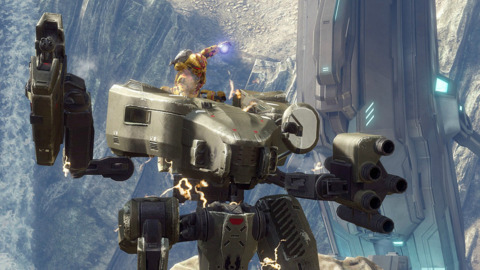
But you'll also face a lot of Covenant opposition, including Grunts, Elites, Jackals, and Hunters. Fighting these guys feels the same way it always has, for better or worse. The Grunts are total chumps, the Elites are fun to bash in the face, the Jackals are never left-handed, and the Hunters are large and slow. As before, the game mixes up your various enemies to serve them up in different configurations. On the normal difficulty, this doesn't make much difference, as you can just plow through the opposition the way a big, armored dude like the Master Chief should. On higher settings, the action gets a little more tactical, forcing you to poke out, do some damage, and hang back to let your shields recharge. Again, this shouldn't sound like much of a surprise to people who have played a Halo game before, but it's just another example of the ways that this new development team made a game that feels very similar to Bungie's work on the previous games. That said, the promise of landing on a new planet and the potential for new experiences and encounters that the change of setting could have allowed for makes the notion of spending what feels like most of the game fighting enemies from old Halo games a little unfortunate.
You'll pick up some new weapons along the way, and the Chief himself has been given some additional abilities. Most of the new weapons drop from the new Promethean enemies. They look great, and the first time you pick one up you'll see it sort of form together into a gun. It's a nice introductory animation that, thankfully, doesn't play out every time you pick up a weapon. While the new weapons look nice, most of them just plug right into the existing Halo archetypes. You'll see a shotgun, a pistol, a fully-automatic rifle, a single-shot rifle that fires three slugs at once (though one sniper-like megaslug if you're zoomed in), a new grenade type, and so on. The new weapons are disappointing for that reason. They don't feel like they fill any real need or plug into any gaps in the existing Halo arsenal. They're just more ways to do the same thing. The game also offers you the chance to pilot a large mech suit in a couple of spots, but taking a large, slow-moving armored guy like the Master Chief and slapping another larger, slower layer of armor around him for a couple of shooting gallery-like sequences isn't exactly my idea of a good time.
Thankfully, the Chief has some more movement options to keep the game running at a solid pace. You can sprint at will now by clicking in the left stick. This does a lot to speed up the pace of the game, as you might expect. But in addition to that, there's also an equipment slot that lets you use armor abilities, similar to the style of Halo: Reach. These include things like Promethean Vision, which lets you see through walls, or Active Camouflage, which gives you a Predator-style invisibility that the AI seems to be able to see right through most of the time. You can also equip abilities that let you deploy auto-sentries, use a large shield, and so on. Being able to sprint without having to equip that as your armor ability is terrific.
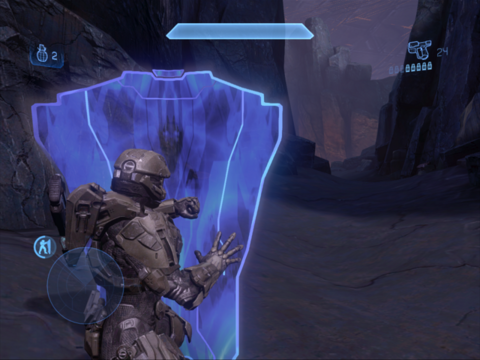
Overall, the Halo 4 campaign is pretty good. It looks fantastic in some spots and it takes you to a lot of different-looking places along the way. It sets up a few story elements that won't pay off until later on in this new trilogy of games, but a lot of the story plays things very safe. At the opening of the game it feels like Master Chief and Cortana could be set off onto some great new mystery in a mysterious place where everything could be different. Instead you spend a lot of time fighting old Halo enemies and, by the conclusion of Halo 4's story, I felt like much of the promise inherent to this potentially new setting had been squandered. Maybe that's on me for wanting Halo to be something other than Halo, but without getting into the specifics of the characters and their fates, where things are left at the end of the game feels like a stopping point that sets you up for more of the same enemies and settings in the future.
The multiplayer side of Halo 4 brings in those new weapons and movement changes, so you can sprint there, as well. There are also additional armor abilities to play with and, overall, it feels like the team sat down with a recent Call of Duty game and found ways to plug some of those concepts into Halo. Some of them are cosmetic. Any points you earn during a match pop up right in the center of the screen. When you die, you get a killcam feed of the person that took you out. But some of them are more dramatic, like more customizable loadouts that let you pick your primary and secondary weapons, a starting grenade type, and a few perks, like shields that recharge more quickly, infinite sprint, the ability to scavenge grenades from fallen Spartans, and so on. As you play, you'll earn experience points that give you unlock points, but some items also have a level requirement before they can even be unlocked. So you'll have to play for a bit before you can start out with plasma grenades, and you'll have to play a little longer before you can equip things in all of your perk slots. Halo has done loadouts before, but this is a deeper, and ultimately, more interesting set of options. As before, you'll also unlock various armor pieces as you play, gain levels, or complete challenges. New helmets, shoulders, chest pieces, and so on are also available for you to play around with.
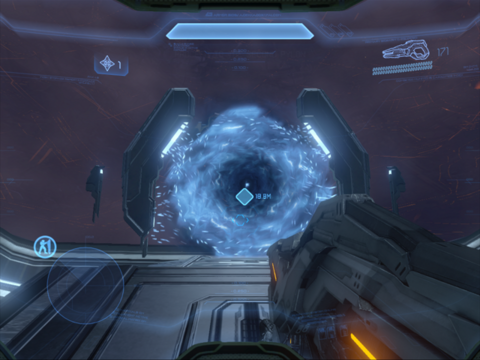
The modes you'll play when playing with the public are your typical sort of Halo modes, but with some changes here and there. Team Slayer (as well as some of the other modes) now allows you to call in ordnance after a set number of kills. Don't start freaking out, you're not calling in air strikes or UAVs or anything that dramatic. And it doesn't require you to earn all those kills in a streak. But when you fill an on-screen meter, it gives you the option to call in one of three different things. They might be weapons, like the SAW, a very rugged light machine gun. Or you might have the option to get an overshield, a temporary speed or damage boost, and so on. One time I got the gravity hammer, but was immediately killed before I got to run around and smash people with it. It's a cool little addition. Other modes include Regicide, which is a standard deathmatch mode but the lead player gets marked by an on-screen indicator and also has an additional bounty on his head. Killing the king gets you that bounty, but doesn't automatically make you the king--you need to be in the lead to wear the crown.
You can also get in and build your own custom matches with a variety of rules settings, and the Forge mode that allows you to alter the placement of items in the multiplayer maps (along with a set of Forge-only maps) also returns with some additional options, like the ability to fuse items together. And, as before, you can take your custom games, screenshots, and so on and share them with other players.
There's no wave-based survival mode in Halo 4. In addition to the campaign, the game also has a cooperative mode called Spartan Ops. This is an episodic series that follows a team of Spartans that work out of the Infinity, a large ship that shows up in the campaign. These episodes are going to be released for free on a regular basis as downloadable updates and will contain video clips that help set them up. The first such episode is included alongside the launching game, and as such that's the only one I can really review at this point. The story opens with a video showing Spartans reporting for duty on-board the Infinity. From there, you're tossed into a set of five missions. The locations are ripped from other parts of the game and are extremely combat heavy. And once you're past that initial cutscene, any additional dialogue is delivered via radio chatter. If you're into the combat of Halo and like playing with others against occasionally overwhelming batches of enemies, the missions are passable. But don't go in thinking that this is some sort of elaborate and unique segment of the game that's going to give you a campaign-level experience. It's a set of co-op missions with a loose story wrapper around it, nothing more, nothing less. You can bring in your custom Spartan from the other multiplayer modes and earn experience points by playing Spartan Ops, and there are mode-specific challenges to complete here, as well.
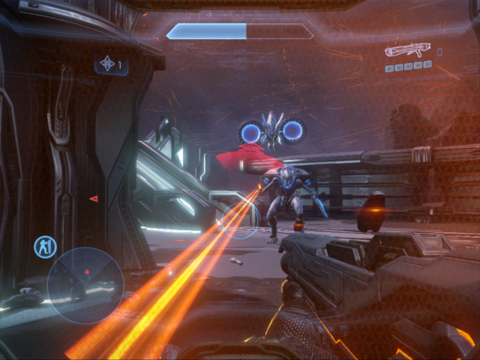
The presentation end of Halo 4 is quite nice. The music is outstanding, breaking away from the franchise's past a bit by updating the sound and getting away from some of the overt monk chanting that one still tends to associate with Halo. It helps make Halo 4 sound like its own thing, and that goes a long way. Visually, Halo 4 has some terrific moments that really stand out, but it also holds up well on the technical end with a good frame rate, great lighting, and, for the most part, sharp texture quality. Again, these things help to make Halo 4 look and feel different from its predecessors, probably more than the gameplay does.
From the moment I saw Master Chief put himself back to sleep at the end of Halo 3, all I could think about was how his next adventure--if he would even have a next adventure--should be something dramatically different from the adventures we had already seen. Moving him out into the middle of nowhere and cutting him off from his allies is an idea with huge potential. So that's why I find the storytelling side of Halo 4 to be fairly disappointing. Within the first few hours you've fought enemies that go all the way back to the first game in the franchise and you've reconnected with the human race. That's not to say that the entire story is a bust--and it does set up some potentially interesting things for the next couple of games to address--but it's good that the developers have backed this story up with sharp, time-tested gameplay that gets enhanced in meaningful ways across all modes.